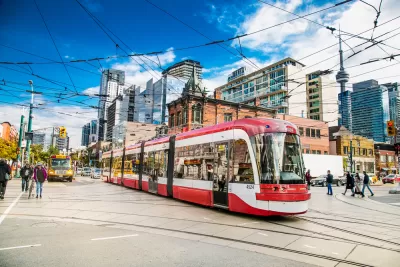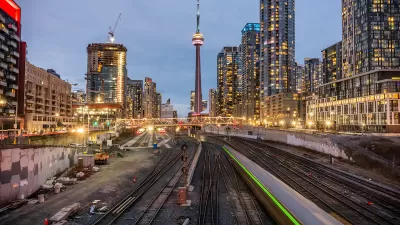A brief outage of traffic lights at one Toronto intersection inadvertently gave area streetcars more priority, speeding up service for transit users.

A temporary glitch in the traffic lights at Queen and Spadina streets in Toronto revealed how improved signal priority could enhance service on local streetcars.
As Jack Landau explains in blogTO, “The malfunctioning traffic signals forced motorists to treat the intersection as a four-way stop. While this was in no way beneficial to the flow of vehicle traffic, it actually made for a head-scratching improvement for streetcars passing through the chaos.” The change in traffic flow “made it easier for Spadina streetcars to cross without needing to wait for left-turning and cross traffic,” explained Derek Ellis on social media.
Transit advocates say the unplanned experiment shows that the city can do more to prioritize transit by using signal timing and dedicated lanes to improve transit speed and reliability. As transit writer Steve Munro put it, “This should be required reading for everyone at City Hall who likes to talk about ‘transit priority.’”
FULL STORY: Broken traffic signals somehow improved Toronto intersection

Planetizen Federal Action Tracker
A weekly monitor of how Trump’s orders and actions are impacting planners and planning in America.

DARTSpace Platform Streamlines Dallas TOD Application Process
The Dallas transit agency hopes a shorter permitting timeline will boost transit-oriented development around rail stations.

Four Reasons Urban Planners Can’t Ignore AI
It’s no longer a question of whether AI will shape planning, but how. That how is up to us.

Bikeshare for the Win: Team Pedals to London Cricket Match, Beats Rivals Stuck in Traffic
While their opponents sat in gridlock, England's national cricket team hopped Lime bikes, riding to a 3-0 victory.

Amtrak’s Borealis Exceeds First Year Ridership Expectations
205,800 passengers have boarded the St. Paul to Chicago line, well above initial MDOT projections.

Study: 4% of Truckers Lack a Valid Commercial License
Over 56% of inspected trucks had other violations.
Urban Design for Planners 1: Software Tools
This six-course series explores essential urban design concepts using open source software and equips planners with the tools they need to participate fully in the urban design process.
Planning for Universal Design
Learn the tools for implementing Universal Design in planning regulations.
City of Mt Shasta
City of Camden Redevelopment Agency
City of Astoria
Transportation Research & Education Center (TREC) at Portland State University
US High Speed Rail Association
City of Camden Redevelopment Agency
Municipality of Princeton (NJ)





























